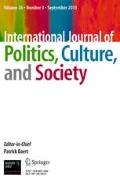Abstract
The struggle over women's rights has been one of the main battlegrounds between the forces of modernity and tradition in Iranian politics and society. With the emergence of a Reformist movement in 1997 this struggle entered a new phase in the Islamic Republic. It became part of the part of a broader conflict over two differing notions of Islam. One is an absolutist and legalistic Islam, premised on the notion of “duty,” tolerating no dissent and making little concession to popular will and contemporary realities. The other is a pluralistic and tolerant Islam that promotes democratic values and human rights—including women's rights.
Similar content being viewed by others
References
ai'Abedini Ahmed, “Sayri dar ayat-e hejab,” Feqh: Kaveshi Now sar Feqh-e Islami 23 (spring, 2000), pp. 48–92.
Hoodfar Homa, “The Veil in Their Minds and on Our Heads: Veiling Practices and Muslim Women,” in Lisa Lowe and David Lloyd (eds), The Politics of Culture in the Shadow of Capital. Durham & London: Duke University Press, 1997, pp. 248–79.
Khiabany Gholam and Sreberny Annabelle, “The Iranian Press and the Continuing Struggle over Civil Society 1988–2000,” Gazette: International Journal for Communication Studies 63 (2–30), 2001, pp. 203–23.
Mir-Hosseini Ziba, “Stretching the Limits: A Feminist Reading of the Shari'a in Iran Today,” in Mai Yamani (ed.), Feminism and Islam: Legal and Literary Perspectives. London: Ithaca Press, 1996a, pp. 284–320.
Mir-Hosseini Ziba, “Women and Politics in Post-Khomeini Iran: Divorce, Veiling and Emerging Feminist Voices,” in Haleh Afshar (Ed.) Women and Politics in the Third World. London & New York: Routledge, 1996b, pp. 153–58.
Mir-Hosseini Ziba, Islam and Gender: The Religious Debate in Contemporary Iran. Princeton University Press, 1999.
Mir-Hosseini Ziba, “The Rise and Fall of Fa'ezeh Hashemi: Women in Iranian Elections,” Middle East Report (MERIP) 218 (spring 2001), pp. 8–11.
Mir-Hosseini Ziba, “Religious Modernists and the 'Woman Question': Challenges and Complicities,” Eric Hooglund (ed.), Iran in Transition. Syracuse University Press, 2002.
Nuri 'Abdollah, Showkaran-e Eslah: Defa'iyat-e Abdollah Nuri (The Hemlock of Reform: Abdollah Nuri's Defence). Tehran: Tarh-e Now, 1378/1999.
Ramazani Nesta, “Women in Iran: The Revolutionary Ebb and Flow,” Middle East Journal 47 (3), 1993, pp. 409–28.
Schirazi Asghar, The Constitution of Iran: Politics and the State in the Islamic Republic. London: I. B. Tauris, 1998.
Zakaria'i Mohammad 'Ali (ed.), Konferans-e Berlin: Khedmat ya Khiyanat (Berlin Conference: Service or Treason). Tehran: Tarh-e Now, 1379/2000.
Author information
Authors and Affiliations
Rights and permissions
About this article
Cite this article
Mir-Hosseini, Z. The Conservative–Reformist Conflict Over Women's Rights in Iran. International Journal of Politics, Culture, and Society 16, 37–53 (2002). https://doi.org/10.1023/A:1016530427616
Issue Date:
DOI: https://doi.org/10.1023/A:1016530427616




